Nash-Healey
| Nash-Healey | |
|---|---|
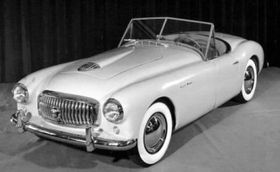 1951 Nash-Healey | |
| Overview | |
| Manufacturer | Nash Motors |
| Production | 1951–1954 |
| Assembly |
|
| Body and chassis | |
| Class | Sports car |
| Body style | |
| Layout | Front-engine, rear-wheel-drive |
| Powertrain | |
| Engine |
|
| Transmission | 3-speed manual with overdrive |
| Dimensions | |
| Wheelbase |
|
| Length |
|
| Width |
|
| Height |
|
| Curb weight | 2,400 lb (1,089 kg) ~ approximate |
The Nash-Healey is a two-seat luxury sports car or gran turismo produced between 1951 and 1954 and marketed by the automaker Nash-Kelvinator as a halo vehicle to promote sales of the other Nash models in North America.
A mating of the upscale Nash Ambassador drivetrain and a handmade European chassis and body, it was the first sports car introduced in the U.S. by a major automaker since the Great Depression.[2] It was the product of the partnership between Nash-Kelvinator and British automaker Donald Healey. Only a year after introduction the car received some styling tweaks by Pinin Farina and subassembly began in Italy.
A racing version, built with a spartan aluminum body, finished third in the 1952 Le Mans 24-hour race.
Origin[]

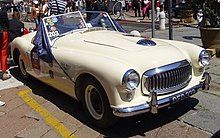
Donald Healey and Nash-Kelvinator CEO George W. Mason met on the RMS Queen Elizabeth, an ocean liner going from the United States to Great Britain. Healey was returning to England after a failed attempt to purchase engines from General Motors' luxury Cadillac division.[3] His objective was to expand production of the Healey Silverstone that race car driver Briggs Cunningham had customized with Cadillac's new 1949 overhead-valve V8 engine.[4] Mason and Healey met over dinner and a production plan ensued during the remainder of the voyage. The two became friends because they were both interested in photography. Mason had a stereo (3-D) camera that intrigued Healey.[5]
The 1951 Nash-Healey was the first post-war sports car from a major American automaker, two years ahead of the Chevrolet Corvette.[6] The custom-built Kurtis-Kraft which predated it never reached "production car" status, with only 18 units being built.[7][6]
A prototype was exhibited at the Paris Motor Show in September 1950. The production model debuted at the February 1951 Chicago Auto Show,[8] followed that month by the Miami Auto Show.[7] Also classified as a grand tourer for its luxury appointments, extreme price, the car served it's purpose and was campaigned in several racing circuits.[9][10][11]
1951[]

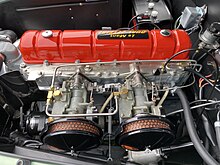
Nash Motors supplied the Donald Healey Motor Company with the powertrain components: the Ambassador's inline six-cylinder OHV 234.8 cu in (3.85 L) engine and three-speed manual transmission with Borg-Warner overdrive, plus torque tube and differential. Healey fitted a lighter, higher-compression aluminum cylinder head (in place of the cast-iron stock item) with twin 1.75-inch (44 mm) SU carburetors that were popular on British sports cars at the time. This increased power from the stock 112 hp (84 kW; 114 PS) version to 125 hp (93 kW; 127 PS). Donald Healey's original plan was to use a heavier 331 cu in (5.4 L) Cadillac V8 engine and the car was designed with an engine bay that allowed a few later owners to convert their cars to V8 power.[12]
The chassis was a widened and reinforced Healey Silverstone[13] box-section ladder-type steel frame. Independent front suspension, also Healey Silverstone, was by coil springs, trailing link, and a sway bar. The rear suspension featured Nash's rear end and coil springs replaced the Silverstone's leaf springs, while the beam axle was located by Panhard rod.
Healey designed the aluminum body, but it was outsourced. Panelcraft Sheet Metal of Birmingham fabricated the body.[8] It incorporated a Nash grille, bumpers, and other trim.[14] Healey was responsible for the car's final assembly.
The car had drum brakes all around. Wheels were steel, dressed up with full-diameter chrome hubcaps and 4-ply 6.40×15-inch whitewall tires. The interior featured luxurious leather upholstery, foam rubber cushions, an adjustable steering wheel, and a cigarette lighter. Completed vehicles were shipped to the United States for sale through the Nash dealership network.
Donald Healey gave the first example to Petula Clark,[8] with the registration number PET 1.[clarification needed] The only colors available were "Champagne Ivory" and "Sunset Maroon". The suggested retail price (MSRP) of US$3,767 F.O.B. New York City was considered to be high priced. [15]
Restyle[]


1952[]
For 1952, Nash commissioned Italian designer Pininfarina to revise Healey's original body design. One objective was to make the sports car more similar to the rest of Nash's models. The front received a new grille incorporating inboard headlights. The sides gained distinct fender character lines ending with small tailfins in the rear. A curved windshield replaced the previous two-piece flat windshield. The restyled car appeared at that year's Chicago Auto Show.[16] Reflecting its role as a halo car, the Nash Ambassador and Statesman models adopted a Nash-Healey-inspired grille with inboard headlights for 1955, and advertising featured the new Nash with a Nash-Healey in the background to show the obvious similarity.
Pininfarina in Turin built the bodies which, save for aluminum hood, trunk lid and dashboard, became all steel.[17] The aluminum panels, plus careful engineering, reduced curb weight.[18] The Nash engine was enlarged to 252 cu in (4.1 L), producing 140 hp (104 kW; 142 PS) with American-made twin Carter Carburetors .
Shipping costs were considerable, and yet moderated by trans-Atlantic success of Kelvinator in the European marketplace. From Kenosha, Wisconsin the Nash engines and drivetrains went to England for installation in the Healey-fabricated frames. Healey then sent the rolling chassis to Italy, where Pininfarina's craftsmen fashioned the bodywork and assembled the finished product. They were then exported to the U.S., with the car's complicated logistical process resulting in a $5,908 sticker price in 1953, approaching double the new Chevrolet Corvette's $3,513.[19]
1953[]
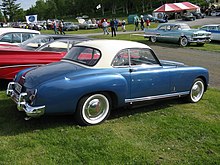
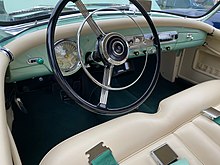
The 1953 model year saw the introduction of a new closed coupé[20] alongside the roadster (now termed a "convertible"). Capitalizing on the 3rd-place finish at Le Mans by a lightweight racing Nash-Healey purpose-built for the race (see below), the new model was called the "Le Mans" coupé.[21] Nash had already named the powerplant the "Le-Mans Dual Jetfire Ambassador Six" in 1952, in reference to the previous racing exploits of the lightweight competition cars.[18]
Some describe the new design as "magnificent".[22] Some "people didn't take to the inboard headlights".[23] This headlight mounting was described as "Safety-Vu" concentrating illumination, and their low position increased safety under foggy conditions. The 1953 "Le Mans" model was awarded first prize in March of that year in the Italian International Concours d'Elegance held at Stresa, Italy.[24]
Leveraging the popularity of golf to promote their cars, Nash Motors and Nash dealers sponsored what the automaker described as "more than 20 major golf tournaments across the country" in 1953, and golfer Sam Snead was shown with his Nash-Healey roadster on the cover of the June 1953 issue of Nash News.[25][26]
Product placement was another marketing strategy. A roadster owned by Dick Powell was driven by George Reeves, as Clark Kent, in four TV episodes of the Adventures of Superman.[27][28] Another roadster appears in the 1954 film Sabrina starring Humphrey Bogart, William Holden, and Audrey Hepburn .[29]
1954[]

Nash Kelvinator became reorganized as a division of American Motors Corporation (AMC) that was formed as a result of a merger with Hudson Motor Car Company on 1 May 1954. Nash was faced with limited resources for marketing, promotion, and further development of this niche market car in comparison to its volume models.[30] By this time AMC knew that a similar luxurious two-seat Ford Thunderbird with V8 power was being planned. In light of the low sales for the preceding years, Nash delayed the introduction of the 1954 models until 3 June and discontinued the convertible, leaving just a slightly reworked "Le Mans" coupé, distinguished by a reverse slanted "C" pillar and a three-piece rear window instead of the previous one-piece glass.
Healey was focusing on its new Austin-Healey 100, "and the Nash-Healey had to be abandoned."[31] Although the international shipping charges were a significant cost factor, Nash cut the POE (port of entry) price by more than $1,200 to $5,128. Production ceased in August. A few leftover 1954s were sold as 1955 models.[32]
Racing[]
Panamericana pace car[]
A Nash-Healey served as the course car for the 1951 Carrera Panamericana, described as one of the most dangerous automobile race of any type in the world. Driven by Chuck Stevenson, the Nash-Healey ran ahead of the racers to ensure the way was clear on "the world's greatest road race".[33]
Endurance racers[]
To create a racing pedigree for the marque Donald Healey built four lightweight Nash-Healeys for endurance racing[34] Like the road cars, they had Nash Ambassador engines and drivelines. However, fitting higher-compression aluminum cylinder heads, special manifolds, and twin SU carburetors increased their power to 200 hp (149 kW; 203 PS). The cars had spartan, lightweight aluminum racing bodies. Three open versions were built, and one coupe. These cars competed in four consecutive Le Mans races and one Mille Miglia.
1950 Le Mans[]
Tony Rolt and Duncan Hamilton debuted the prototype at Le Mans in 1950. It was the first-ever Le Mans entry to have an overdrive transmission. Not only was the car one of the 29 finishers from the field of 66,[35] but also finished in fourth place. This outstanding achievement sealed Healey's contract with Nash for a limited production run of the road cars.[36] Roger Menadue, head of Healey's experimental department, played a significant role in the success: He filed slots in the backplates of the brakes and extended the adjusting mechanism to a small exterior lever. Thus in a matter of seconds, he could adjust the brakes during pit stops without jacking the car up—an innovation that was said to save as much as half an hour at each stop.[37]
1951 Le Mans[]
In the 1951 Le Mans race Rolt and Hamilton (who would win two years later in a Jaguar C-Type) took fourth in class and sixth overall behind a Jaguar, two Talbot-Lagos and two Aston Martins. They finished immediately ahead of two Ferraris and another Aston Martin.[38]
1952 Le Mans[]

In the 1952 Le Mans race, when only 17 of the 58 starters finished, the entry driven by Leslie Johnson—a driver with the flair of Nuvolari, said Louis Chiron—and motoring journalist Tommy Wisdom[39] took third overall behind two factory-entered Mercedes-Benz 300SLs; also first in class, ahead of Chinetti's Ferrari, and second in the Rudge-Whitworth Cup for the best performance over two consecutive years. In addition, they won the Motor Gold Challenge Cup. The drivers said the car was more nimble through the corners than its more exotic competitors. It delivered 13 mpg‑US (18 L/100 km; 16 mpg‑imp) and the engine needed no oil or water during the entire 24 hours.[40] The car had been built from scratch in a fortnight, Menadue and his assistant Jock Reid fabricating the body in less than a week, by eye, without any drawings. Healey said: "That's an ugly bugger, isn't it, Roger?"[37]
1952 Mille Miglia[]
The same year, Johnson raced the car in the Mille Miglia, the thousand-mile Italian road race that would be banned as too dangerous five years later. Daily Telegraph motoring correspondent Bill McKenzie rode as passenger.[41] They finished a creditable seventh overall to Bracco's winning works team Ferrari, the works Mercedes-Benz 300SLs of Kling and Caracciola, and three works Lancias;[42] they also took fourth in class. The coupe driven by Donald Healey and his son Geoffrey crashed out.[40]
1953 Le Mans[]
For the 1953 Le Mans race the factory partnered Johnson with Bert Hadley in one of two cars with redesigned bodies. Johnson started from 27th place. Although he and Hadley advanced steadily up the race order they were 11th at the finish, 39 laps behind the winning Jaguar, despite an average speed of 92.45 miles per hour (148.78 km/h)—higher than the previous year's run to third place.[21] However, they beat both of Donald Healey's new Austin-Healey 100s. The second Nash-Healey of Veyron and Giraud-Cabantous retired after nine laps.
This concluded the factory's race program with the lightweight competition cars. The 1952 Le Mans/Mille Miglia car passed into private ownership and raced in America.[43]
Legacy[]
American Motors continued to offer halo and performance models after the discontinuation of the Nash-Healey as well as marketing foreign-assembled niche-market, the two-passenger sub-compact Metropolitan.
In 1956, American Motors introduced its first V8 engine, a 250 cu in (4.1 L), overhead-valve engine with a forged crankshaft, which produced 190 hp (142 kW; 193 PS) when equipped with the standard 2-barrel carburetor. In 1957, AMC bored - from 3.5 to 4 in (89 to 102 mm) - its new V8 to 327 cu in (5.4 L) and used it in the last year of AMC's luxury offerings, the Nash Ambassador, and Hudson Hornet. This engine was also featured in the all-new "compact" Rambler Rebel, with mechanical valve lifters and rated at 255 hp (190 kW; 259 PS) with a 4-barrel carburetor and 288 hp (215 kW; 292 PS) with the optional Bendix Electric fuel-injection system. A fuel-injected Rambler Rebel was entered in the Pure Oil Daytona competition but this version never entered regular production due to driveability issues. Nonetheless, the Rambler Rebel is credited for being the first factory-produced muscle car, and as quicker than the Chrysler 300B, Dodge D500, Desoto Adventurer, and all other American sedans in 1957. The only car quicker was the 4-speed manual, small-block, 283 cu in (4.6 L) fuel-injected Chevrolet Corvette.
The 327 V8 would have been quite an addition to the Nash Healey. The Automobile Manufacturers Association eventually instituted limits on automakers sponsorship of activities that glamorize speed and performance in 1957.[44] American Motors observed both the letter and spirit of AMA's resolution, avoided the auto industry's horsepower race by offering ever more powerful engines.[45] In 1964, American Motors even adopted the advertising slogan, "Why don't we enter high-performance Rambler V-8s in racing? Because the only race Rambler cares about is the human race!"[46][47] The automaker focused on its successful compact Rambler American line, midsize Rambler, and luxury oriented Ambassador.
American Motors would not have a truly sporty car until the 1965 Rambler Marlin fastback. For 1968, AMC introduced out the 4-seater Javelin, and the 2-seat AMX. The Penske Javelins dominated the Trans Am series, defeating the Ford Mustang, Chevrolet Camaro, Plymouth Barracuda, and other pony cars.
Production[]

All 1951 Nash-Healeys were British-built. Bodies were crafted at Panelcraft Sheet Metal and final assembly was completed at the Healey factory in Warwick. The 1952 through 1954 models were built in Italy by Pinin Farina.
| Nash-Healey production numbers | |
|---|---|
| 1951 | 104 |
| 1952 | 150 |
| 1953 | 162 |
| 1954 | 90 |
| Total | 506 |
The Nash-Healey registry has a total of 520 entries including prototypes and race vehicles.[48]
For contextual comparison, the Nash-Healey is framed in U.S. auto history with the 1953 Kaiser Darrin, 1953 Chevrolet Corvette, and 1955 Ford Thunderbird. The 1954 model year Nash-Healey price to the public was close to $6,000 compared with around $3,500 for a Chevrolet Corvette and $3,000 for a 1955 Ford Thunderbird.[4]
References[]
- Inline
- ^ "1953 Nash album". oldcarbrochures.com. pp. 6–7. Retrieved 2 November 2020.
- ^ "Nash Builds a Sports Car". Popular Mechanics. 95 (3): 107–109. March 1951. Retrieved 13 April 2015.
- ^ Roth, Frederick J. (June 2003). "Nash Healey". American Sports Cars. Retrieved 13 April 2015.
- ^ Jump up to: a b Wilson, Jeremy. "History and Production Notes". Popular Restorations. Retrieved 2 November 2020.
- ^ Schreiber, Ronnie (2 August 2014). "Stereo Realists: Donald Healey, George Mason and How the 3D Craze Led to the Nash-Healey". The Truth About Cars. Retrieved 2 November 2020.
- ^ Jump up to: a b Jedlicka, Dan. "1951-54 Nash-Healey History". Retrieved 13 April 2015.
- ^ Jump up to: a b Bomstead, Carl (August 2013). "1950 Nash-Healey Roadster". Retrieved 13 April 2015.
- ^ Jump up to: a b c Hulme, Ann. "From Ann Hulme". Nash Car Club. Retrieved 13 April 2015.
- ^ Langworth, Richard M. (1986). Consumer Guide (ed.). Complete book of collectible cars, 1930-1980. Random House. pp. 174–175. ISBN 9780517479346. Retrieved 9 March 2019.
Le Mans roomy, a genuine GT
- ^ Wagner, Rob Leicester (1998). Style and Speed: The World's Greatest Sports Cars. MetroBooks. p. 35. ISBN 9781567996333.
- ^ "U.S. Challenge in the Le Mans 24 Hours Race". The Motor. 125: 60. 1964. Retrieved 9 March 2019.
- ^ "1951 Nash Healey Roadster". Anamera. 26 June 2008. Retrieved 13 April 2015.
- ^ Auto Editors of Consumer Guide (24 October 2007). "1950 Healey Silverstone". auto.howstuffworks.com. Retrieved 2 November 2020.
- ^ Vance, Bill (1994). Reflections on automotive history, Volume 1. Eramosa Valley Publications. p. 137. ISBN 9780969892205.
- ^ Vance, Bill (16 September 2005). "Reflections: Healey's creations helped make British sports cars popular". The London Free Press.
- ^ "1952 Nash-Healey". Pacific Northwest Region Nash Car Club of America. Retrieved 13 April 2015.
- ^ LaChance, David (1 October 2007). "1953 Nash-Healey LeMans Coupe". Hemmings Sports & Exotic Car. Retrieved 13 April 2015.
- ^ Jump up to: a b Auto Editors of Consumer Guide (27 October 2007). "1952 Nash-Healey". Archived from the original on 26 January 2020. Retrieved 2 November 2020.
- ^ Lyons, Dan (2005). Cars of the Fantastic '50s. MBI Publishing. pp. 43–45. ISBN 9780873499262. Retrieved 13 April 2015.
- ^ "Nash-Healey Adds LeMans Hardtop to Sports Line". Popular Mechanics. 99 (5): 101. May 1953. Retrieved 13 April 2015.
- ^ Jump up to: a b Auto Editors of Consumer Guide (27 October 2007). "1953 Nash-Healey". Archived from the original on 19 September 2020. Retrieved 2 November 2020.
- ^ Adler, Dennis; Moss, Stirling (2001). Mercedes-Benz: Silver Star Century. MBI Publishing. p. 90. ISBN 9780760309490. Retrieved 13 April 2015.
- ^ Langworth, Richard M. (1975). Kaiser-Frazer, the last onslaught on Detroit: an intimate behind the scenes study of the postwar American car industry. Automobile Quarterly Publications. p. 200. ISBN 9780915038046.
- ^ Conde, John (8 September 1975). "Nash-Healey (1951-54)". carmemories. Retrieved 13 April 2015.
- ^ "Nash cashes in on the popularity of golf to sell more cars". Nash News. Nash Motors. June 1953.
- ^ "Nash-Healey Roadster - Auction 20-21/1, Listing Date: 6 December 2010". carandclassic.com. Archived from the original on 7 September 2011. Retrieved 13 April 2015.
- ^ Koza, Lou (15 April 2006). "This is a car ... for Superman!". The Adventures Continue Website. Retrieved 13 April 2015.
- ^ Watterson, Thomas (31 January 1991). "Collectibles: Porky Pig Meets The Big, Bad Wolf". The Boston Globe.
His collection includes the "Superman car," a 1953 Nash-Healey driven by the Clark Kent character in the 1950s television series.
- ^ "Sabrina (1954) Trivia". Internet Movie Cars Database. Retrieved 13 April 2015.
- ^ Auto Editors of Consumer Guide (27 October 2007). "The Nash-Healey's Demise". Archived from the original on 18 October 2018. Retrieved 2 November 2020.
- ^ Bonds, Ray (2003). Illustrated Directory of Sports Cars. MBI Publishing. pp. 378–379. ISBN 9780760314203. Retrieved 13 April 2015.
- ^ Auto Editors of Consumer Guide (27 October 2007). "1954 and 1955 Nash-Healey". Archived from the original on 29 July 2018. Retrieved 2 November 2020.
- ^ Tipler, Johnny; Ramirez, Jo (2008). La Carrera Panamericana: "The World's Greatest Road Race!". Veloce Publishing. p. 26. ISBN 9781845841706. Retrieved 13 April 2015.
- ^ Kaufmann, Richard M. (October 1970). "Nash-Healey at Le Mans". Special Interest Autos. Hemmings. Retrieved 13 April 2015.
- ^ Auto Editors of Consumer Guide (27 October 2007). "The Nash-Healey and the 1950 LeMans 24 Hours". Archived from the original on 2 July 2017. Retrieved 2 November 2020.
- ^ Conde, John (8 September 1975). "Nash-Healey (1951-54)". AMX Files. Archived from the original on 27 March 1997. Retrieved 13 April 2015.
- ^ Jump up to: a b "Roger Menadue: Motor engineer whose unorthodox approach fuelled the race-circuit success of the Healey's stable". The Times. 22 March 2003. Retrieved 13 April 2015.
- ^ Auto Editors of Consumer Guide (27 October 2007). "1951 Nash-Healey". Archived from the original on 26 January 2020. Retrieved 2 November 2020.
- ^ "Image Preview: Tommy Wisdom, winner of the Grand Turismo Class of the Mille Miglia". Motoring Picture Library. 2004. Retrieved 13 April 2015.
- ^ Jump up to: a b Auto Editors of Consumer Guide (27 October 2007). "The Nash-Healey's 1952 Racing Record". Archived from the original on 26 January 2020. Retrieved 2 November 2020.
- ^ "Sports Cars on Stamps". Car Keys. 12 August 2004. Archived from the original on 12 August 2004. Retrieved 13 April 2015.
- ^ "World Sports Racing Prototypes, Non Championship Races 1952, Mille Miglia results". wsrp.ic.cz. 24 December 2011. Archived from the original on 22 February 2015. Retrieved 13 April 2015.
- ^ Wheels TV Film about the 1952 Le Mans/Mille Miglia Nash Healey; includes Le Mans footage. Retrieved 22 March 2008. Archived 22 September 2008 at the Wayback Machine
- ^ Schorr, Martyn L. (2009). Tales of a Motion Performance Muscle Car Builder. MotorBooks International. p. 15. ISBN 9780760335383. Retrieved 13 April 2015.
- ^ "Auto Makers Get Warning on Speed From A.M.C. Chief". The New York Times. 19 January 1963. Retrieved 13 April 2015.
- ^ "Only race Rambler cares about is the human race (AMC advertisement)". Life. 56 (24): 129. 12 June 1964. Retrieved 13 April 2015.
- ^ Mitchell, Larry G. (2000). AMC muscle cars. MBI Publishing. p. 12. ISBN 9780760307618. Retrieved 13 April 2015.
- ^ "Information Chassis Numbers". Nash-Healey Registry. Retrieved 13 April 2015.
- General
- Conde, John A. (1987). The American Motors Family Album. American Motors Corporation. OCLC 3185581.
- Gunnell, John, ed. (1987). The Standard Catalog of American Cars 1946-1975. Krause Publications. ISBN 9780873410960.
- Clarke, R.M. (1997). Nash & Nash-Healey: 1949-1957. Brooklands Books. ISBN 9781855203662.
External links[]
| Wikimedia Commons has media related to Nash-Healey vehicles. |
- Adolphus, David Traver (30 January 2013). "Sports Car One: The first Nash-Healey restored, heads to auction". Hemmings Daily.
- Strohl, Daniel (11 March 2007). "SIA Flashback – Nash-Healey at LeMans". Hemmings Daily.
- "1952 Nash-Healey Roadster". supercars.net.
- "The Nash Healey restoration and documentation website".
- "America on the move: '50s sporty cars' postage stamps and postal cards roll out of Detroit" (Press release). USPS. Archived from the original on 6 June 2011.
- "Nash Healey Owners Group".
- "Nash Car Club".
- Nash-Healey at the Internet Movie Cars Database
| show |
|---|
- Defunct motor vehicle manufacturers of the United States
- Nash vehicles
- Rear-wheel-drive vehicles
- Sports cars
- Grand tourers
- Pininfarina
- Cars introduced in 1951